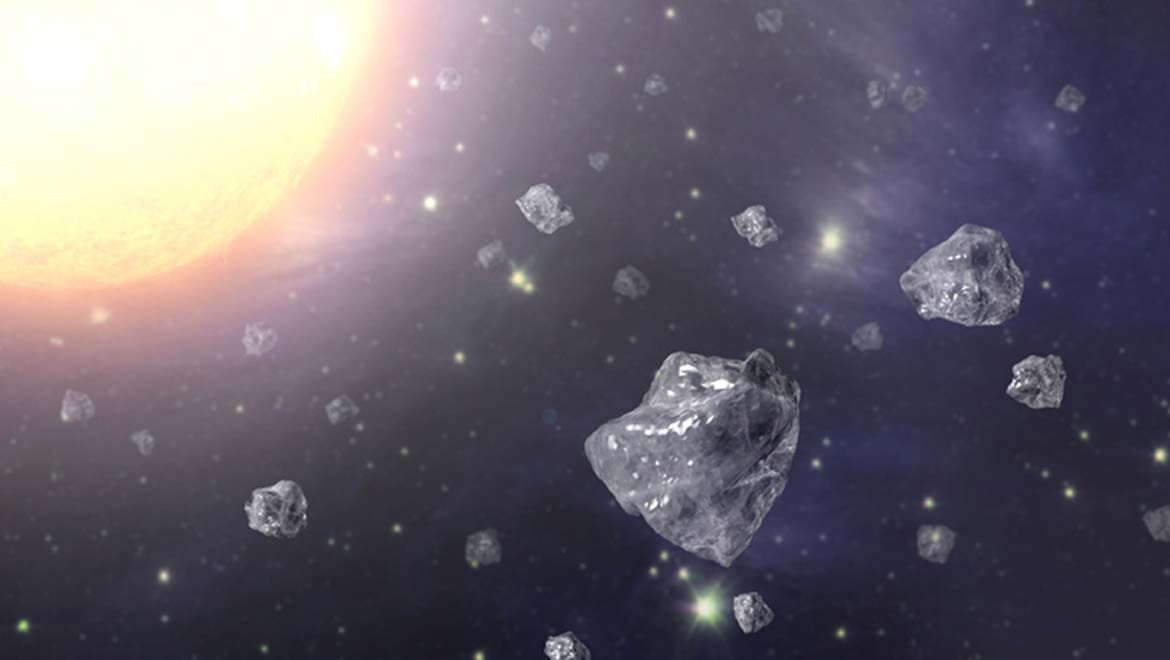“Nothing happens until something moves.” - Albert Einstein
In 2008, in the Nubian Desert (Sudan), scientists discovered a meteorite with diamonds, surrounded by layers of graphite. This asteroid-turned-meteor that hit the Earth was 4 meters in diameter and came to be known as 2008 TC3. This body was considered as a compelling discovery because it revealed many secrets, dating back to the beginning of our solar system.
New research suggests that these diamonds could have only formed within a planet that no longer exists, the long-lost planet.
It is speculated that the rock arrived from a probably destroyed planet, that orbited our sun billions of years ago. This is the first time in history that researchers have discovered fragments, as a remnant of a destroyed planet, from the early ages of our solar system.
The study is published in Nature Communications.
Our solar system is gravitationally-bound and contains the sun and bodies that orbit it, such as planets, asteroids, moons, comets, and meteorites. The sun and the solar system orbit in the center of the Milky Way Galaxy. It takes about 230 million years to make one complete orbit around the Milky Way, as the galaxy is 100,000 light years in diameter.
Inside the solar system, it is possible to find a lot of evidence that reveals the history of this part of our universe.
“Precious” Secrets of our Universe
Scientists suggest that diamond fragments in the meteorite hailed from a long-lost planet. (Source: GeoBeats News)
The largest asteroid is about 329 miles in diameter and each of these have irregular shapes. The composition of the asteroids depends on their distance from the sun and the radius of the orbit. The three broad classes of asteroids are C-, S-, and M-.
- The C-type is a unique category and consists of clay and silicate rocks. These asteroids have a dark color and belong to a class with the most ancient objects in the solar system. It is estimated that the C-type can contain up to 22% water and have never reached temperatures above 50°C.
- The S-types, known as "stony", are metallic and contain silicate materials.
- The M-types are made up of nickel-iron and are located in the middle region of the asteroid belt, where the circumstellar disc between the orbits of the planets Mars and Jupiter exists.
Farhang Nabiei, a materials scientist at the Swiss Federal Institute of Technology in Lausanne (EPFL), Switzerland, and his colleagues, examined the contents of the rock for an extended period of time.
They found that it belonged to a rare category of meteorites known as ureilites. Ureilites are rich in diamonds, but scientists are still trying to understand the specific mechanisms that formed them.
The size of the gems is much larger than any other meteorite diamond that has ever been found before. The diamonds also contain tiny imperfections called inclusions. It is these characteristics that made the diamond extraordinary. They were also used as information to understand the long history of the element.
According to an extensive analysis, the researchers found that the diamonds contained chromite, phosphate and iron-nickel sulfides.
Every bit of data converges into an important discovery, especially when it comes to the historical structure of the solar system.
The materials in questions came from sharp shocks of temperature and pressure. The diamonds were formed by an intense pressure of about 20 GPa (giga-Pascals; unit of pressure), which is close to the pressure seen 400 miles below Earth's surface, where the upper mantle transitions into the lower mantle.
This incredibly high pressure led to the belief that the meteorite is a part of a destroyed planet, which was a planetary "embryo", with the size of that between Mercury and Mars.
The History of our Solar System
Our solar system was believed to have started with proto-planets. These bodies, constituted by chunks of rock and dust, circled the sun for 4.5 billion years. Later, they collided with each other and formed our planets.
The examination of meteorite's structure confirmed the contents of this theory.
The chemistry of the diamonds doesn't match with the planets of today’s universe. So, it is assumed that they were, in fact, leftovers from a proto-planet, that existed approximately 4.56 billion years ago.
This discovery is important as we have the remnants of a previous version of the solar system.
After the collision of this proto-planet with another one, debris was expelled that ended up in the asteroid belt. Thus, the debris wandered for billions of years before plunging to Earth.
"We have in our hands a piece of a former planet that was spinning around the sun before the end of the formation of today's solar system.", said Philippe Gillet, a planetary scientist at the Federal Institute of Technology in Lausanne, Switzerland, and author of the paper published in Nature Communications.
This finding is an important piece of the puzzle that can lead to a deeper understanding of our solar system. But, the most interesting part is that the scientists, now, have a more secure direction for future experimental studies.
Discoveries in astronomy and physics have taken us on amazing journeys that reveal new perspectives of our universe.
Scientists are involved in many experiments in an effort to improve the understanding of the nuances of space. Hopefully, this will fuel the next generation of researchers into making the right conjectures, about our universe, in the future.
Top Image: “Extraterrestrial” diamonds are those formed outside the Earth, and are known to be abundant in meteorites. (Source: Wikipedia)
References
Charles Choi, 2018. Meteoric Diamonds Are Evidence of Long Lost Planets. [Online] Available at: http://www.astronomy.com/news/2018/04/meteoric-diamonds-are-evidence-of-long-lost-planets
George Dvorsky, 2018. Diamonds Packed Inside Rare Meteorite Offer Clues to a Destroyed Planet. [Online] Available at: https://gizmodo.com/diamonds-found-packed-inside-rare-meteorite-are-evidenc-1825351377
Mike Vehner, 2018. Origin of diamonds found in meteorite have been traced to a long-lost planet.
[Online] Available at: http://bgr.com/2018/04/19/diamond-meteorite-lost-planet-evidence/







No comment